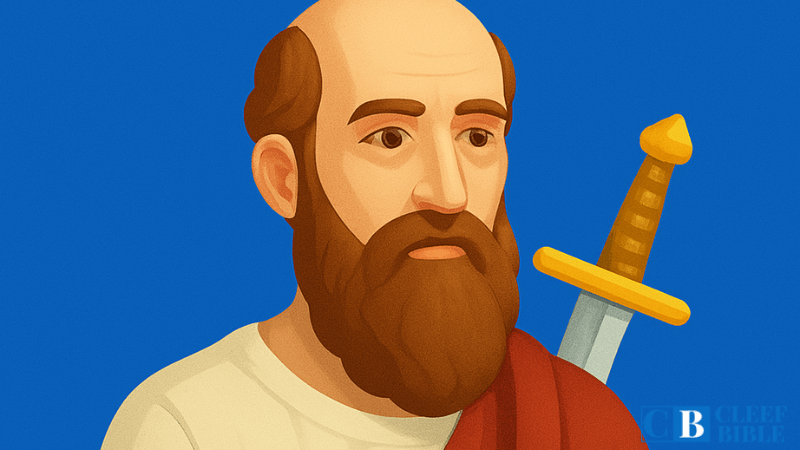How is it possible that the greatest persecutor of Christianity became its most fervent defender?
The story of the apostle Paul is not only a tale of radical transformation, but a living testimony to the power of the gospel. From a ruthless Pharisee to an architect of Christian theology, his life spanned continents, cultures, and prisons, leaving a lasting mark on us today.
Through his letters, missionary journeys, and teachings, Paul not only preached faith in Christ: he lived it, suffered it, and celebrated it. This article invites you to discover Who was the apostle Paul really?, what made it so influential and why His voice continues to resonate in every corner of the church and in the heart that seeks the truth.
Why is Paul a key figure in Christianity?
The apostle Paul is, without a doubt, one of the most influential figures in all of Christianity. Although he was not one of the original twelve disciples, His personal encounter with the risen Christ radically transformed his life and turned it into the missionary apostle par excellenceIt was he who took the gospel beyond the borders of Judaism, founding churches in key cities of the Greco-Roman world, preaching boldly, and leaving a doctrinal legacy that has shaped the Christian faith to this day.
Paul not only preached the gospel, but lived and suffered for him, facing persecution, prisons, shipwrecks and rejection. His life represents the model of total dedication, passion for Christ and zeal for the truth. For this reason, his name remains one of the fundamental pillars in the expansion of Christianity.
The influence of his letters on Christian doctrine
The Pauline epistles They are not just occasional letters: they are doctrinal treasures which explain in depth the work of Christ, salvation by grace through faith, the role of the Holy Spirit, the identity of the believer, and life in community.
Among his key contributions are:
- The justification by faith (Romans, Galatians)
- The unity of the body of Christ (Ephesians, 1 Corinthians)
- The call to joy and contentment in the midst of suffering (Philippians)
- Practical instructions on leadership, family, ethics and worship
Christian theology, especially Reformed theology, has its roots deeply rooted in the teachings of Paul. Through his writings, The Holy Spirit has guided generations to a deeper understanding of the heart of the gospel..
What does his life teach us about the transforming power of the gospel?
Pablo went from being Saul, fierce persecutor of Christians, to be the most passionate messenger of ChristThis change was not the result of personal motivation or philosophy, but of real encounter with the risen ChristHis conversion testifies that The gospel has the power to break chains, change mentalities and redirect destinies.
His life teaches us that:
- No one is too far away to be reached by God's grace.
- The past does not determine the future when Christ intervenes
- A transformed heart becomes a powerful instrument in the hands of God.
Paul was not only transformed, but lived as a testimony of that redemptive power, bringing hope to the Gentiles, forming disciples, and writing truths that continue to renew hearts today.
Origins and cultural context of Paul
Saul of Tarsus: Roman Citizenship and Jewish Education
Paul, whose Hebrew name was Saul, was born in Tarsus, a prominent city in Cilicia, in present-day Türkiye. He came from a Jewish family from the tribe of Benjamin, but it was also Roman citizen by birth (Acts 22:28), which granted him unique privileges within the empire. This dual identity, Jewish by religion and Roman by right, allowed him to move with authority in different cultural contexts and was key to his later missionary ministry.
Pharisaic education under Gamaliel
From a young age, Paul was sent to Jerusalem to receive religious training at the feet of Gamaliel, one of the most respected Pharisee teachers of his time (Acts 22:3). His education made him a expert in Mosaic Law, with a worldview deeply rooted in Jewish legalism. This Pharisaic preparation shaped him as a man intellectually brilliant, deeply religious and jealous of traditions.
Tarsus and the Greco-Roman environment
Tarsus was not just any city: it was a university and cultural center of the Greco-Roman world, famous for its philosophy and rhetoric. Growing up in that environment, Saul also acquired a mastery of Greek language, Hellenistic thought and argumentative logic, tools that he would later use effectively to preach the gospel in synagogues, squares and Roman courts.
Paul, therefore, was shaped by three worlds simultaneously: the Judaism of law, the Greek culture of reason, and the Roman citizenship of power. All of this paved the way for a global mission.
Paul as a persecutor of the church
His zeal for the law and traditional Judaism
Before converting to Christianity, Paul was a radical Pharisee who viewed Jesus' followers as a heretical threat to JudaismHis zeal for the law led him to fiercely persecute Christians, believing that he was defending the purity of his fathers' faith. He himself confessed:
“As for zeal, persecutor of the church…” (Philippians 3:6)
This religious fervor, though sincere, was deeply misguided and made him one of the most feared enemies of nascent Christianity.
The approval of the martyrdom of Stephen
Paul first appears in the book of Acts during the arrest and murder of Esteban, the first Christian martyr. He did not throw stones, but gave his consent and guarded the garments of those who did so (Acts 7:58–8:1). This event marked the beginning of a wave of persecution in which Paul was a key player, and which led to the dispersion of the early church.
His way to Damascus with the intention of arresting Christians
In his zeal to wipe out the “sect of the Nazarene,” Paul asked the high priest for letters of authorization to go to Damascus and arrest the believers there (Acts 9:1–2) He was willing to travel hundreds of miles just to eradicate what he considered a heresy.
But on that path, when he was full of authority and fury, came face to face with the risen Jesus, and his life took an irreversible turn. What was supposed to be an arrest mission turned into the beginning of his calling as an apostle of Christ.
The encounter with Christ and his conversion
The vision of the risen Jesus on the road to Damascus
As Saul approached Damascus with the intention of arresting the Christians, a bright light from heaven surrounded him suddenly, and fell to the ground. Then he heard a voice saying:
“Saul, Saul, why do you persecute me?”
“Who are you, Lord?” he asked.
“I am Jesus, whom you persecute.” (Acts 9:4-5)
This was a direct encounter with the risen Christ, the moment that would mark the complete break with his old life. It was not a subjective vision nor a philosophical change, but a supernatural revelation that left him speechless… and sightless.
Physical blindness and spiritual awakening
After the vision, Paul He went blind for three days, without eating or drinking (Acts 9:9). This literal blindness symbolized his previous spiritual condition: He had been a man of knowledge, but without the truth. Temporary darkness prepared his heart for really see for the first time, no longer with human eyes, but with faith.
During those days, alone, humiliated and confused, began to pray, marking the beginning of his new relationship with God (Acts 9:11).
The role of Ananias and his baptism
God sent to Ananias, a faithful disciple in Damascus, to pray for Saul. Although he was initially afraid to approach him, he obeyed God's instruction. As he laid his hands on him, Ananias said:
“Brother Saul, the Lord Jesus… has sent me so that you may regain your sight and be filled with the Holy Spirit.” (Acts 9:17)
Immediately They fell from his eyes like scales, regained his sight and was baptizedThrough Ananias, Paul not only received physical healing, but confirmation of his calling and communion with the church.
First steps in your new faith
After his conversion, Paul was never the same againFrom persecutor he became a preacher. He began to proclaim in the synagogues that Jesus is the Son of God, surprising all who knew him by his previous reputation (Acts 9:20–21).
Although he faced suspicion and opposition, his transformation was undeniable. He withdrew to Arabia for a time (Galatians 1:17), possibly to receive direct revelation from the Lord and to prepare himself spiritually. He then returned to Damascus and later to Jerusalem, beginning a path that would lead him to become the most influential apostle of the New Testament.
His conversion was not a superficial change, but a total surrender to the power of graceHis life would prove that No one is beyond the reach of God's mercy.
Paul as an apostle to the Gentiles
Special calling and commission from the Lord
From the moment of his conversion, God made it clear that Paul had a specific and radically different mission to that of the other apostles: to bring the gospel to the Gentiles. Jesus said to Ananias:
“This is a chosen vessel of mine to bear my name before the Gentiles, and kings, and the children of Israel.” (Acts 9:15)
This call was not my own initiative, but a direct commission from the LordUnlike Peter, whose work was concentrated on the Jews, Paul was sent beyond the borders of Israel, to pagan territories, strategic cities of the Roman Empire and cultures completely alien to Judaism.
Why did you focus on non-Jews?
Although Paul always began preaching in the synagogues of each city, his message was consistently rejected by many religious Jews. On the other hand, the Gentiles without knowing the Law They received the gospel with openness and faith.
This pattern became so evident that he himself declared:
“It was necessary that the word of God should be spoken to you first; but… behold, we are turning to the Gentiles.” (Acts 13:46)
Paul understood that the gospel was for everyone, and that his role was open the door of the Kingdom to those who were previously far awayHis identity as a Pharisee surrendered to his calling as an apostle of grace.
The tension between Judaism and the gospel of grace
One of the greatest challenges of Paul's ministry was facing the resistance of the Judaizers, who insisted that Gentiles must keep the Law of Moses (circumcision, diet, etc.) to be saved.
Paul passionately defended the truth that Salvation is by grace alone through faith, without the need for legal additions. This tension is evident in letters such as Galatians and Romans, where it shows:
- That the Law cannot justify the sinner
- That Christ has already fulfilled everything necessary
- That in Him there is neither Jew nor Greek, but a new reconciled humanity
His teaching was revolutionary and scandalous for many, but fundamental to understanding the biblical gospel.
His defense of the gospel before the apostles in Jerusalem
In Acts 15, Paul participated in the Council of Jerusalem, a key meeting where the apostles and elders discussed whether Gentile believers should obey Jewish law. Paul argued strongly:
- That God had already poured out the Spirit on the lawless Gentiles
- That imposing the Law on them was carry a yoke that not even the Jews could bear
- That salvation is only by the grace of the Lord Jesus (Acts 15:11)
His intervention, along with the confirmation of Peter and James, led to a historic resolution: not to impose the Law on the Gentiles, but to affirm that faith in Christ is enough.
So, Paul He affirmed his apostolate and protected the freedom of the gospel and paved the way for the global expansion of the church.
His missionary journeys
First missionary journey: Asia Minor
He Paul's first missionary journey started from Antioch together with Barnabas and John Mark (Acts 13–14). They traveled through Cyprus and various regions of Asia Minor, such as Pisidia, Iconium, Lystra and DerbeDuring this tour:
- They preached first to the Jews in the synagogues, but then to the Gentiles.
- They faced each other opposition, persecution and even stoning (as in Lystra).
- They founded new Christian communities and strengthened the faith of the believers.
This trip marked the beginning of the Pauline missionary model: enter key cities, preach the gospel, make disciples, and establish churches.
Second trip: Macedonia, Greece and the Areopagus in Athens
In his second missionary journey, Pablo traveled with Silas (and later Timothy and Luke joined him), and he was led by a vision to cross to Macedonia (Acts 16–18), opening the gospel to Europe. Featured cities:
- Philippi: conversion of Lydia, liberation of a young slave girl and miraculous imprisonment.
- Thessalonica and Berea: some believed, others rioted.
- Athens: At the Areopagus, Paul gave a philosophical-theological discourse, adapted to Greek thought, announcing the “unknown God” as the true resurrected Lord.
- Maroon: spent a year and a half planting a strong church in the midst of a morally corrupt city.
This trip showed Paul's ability to adapt the message without altering the gospel, and how the gospel penetrated intellectual and commercial centers.
Third trip: Ephesus and strengthening of churches
In his third trip (Acts 18:23–21:14), Paul focused on consolidate and teach to the previously founded churches. The center of his mission was Ephesus, where he stayed for about three years:
- He taught at the school in Tiranno daily.
- He performed miracles and faced conflicts with local idolatry.
- He raised up leaders and sent workers from there.
He also went through Macedonia, Corinth and Miletus, from where he delivered a moving speech to the elders of Ephesus. This trip underlines his pastoral role and training of leaders, as well as an evangelist.
Final journey to Rome and his imprisonment
After being arrested in Jerusalem Unjustly, Paul appealed to his Roman citizenship and was sent to Rome to appear before Caesar (Acts 21–28). The journey included:
- A shipwreck in Malta
- Ministries in the midst of danger
- Even being imprisoned, he preached freely, writing powerful letters (such as Philippians, Colossians, and Philemon).
Although he was a prisoner, the gospel was notHis final testimony in Rome inspired courage and faithfulness in the early church.
Maps, routes and contributions (Barnabas, Silas, Timothy, Luke)
Paul's travels were not solitary undertakings. He always traveled as a team, reflecting his vision of collaborative and formative ministryAmong his most notable colleagues are:
- Barnabas: his first mentor and initial partner.
- Silas: faithful collaborator during the second trip.
- Timothy: spiritual disciple who became a pastor and ministerial heir.
- Luke: physician, historian, and author of Acts; he accompanied Paul at several key moments.
The maps that record his missionary routes cover thousands of kilometers, crossing continents and cultures. His legacy It is not only theological, but geographical and communal: He planted churches in the heart of the Greco-Roman world.
Every city visited, every companion trained, and every letter written are part of Paul's immense apostolic legacy.
The letters of the apostle Paul
Classification: Pauline epistles (authentic and debated)
The apostle Paul wrote at least 13 letters that appear in the New Testament, known as Pauline epistlesScholars classify them into two groups:
- Authentic Epistles (without debate about authorship): Romans, 1 and 2 Corinthians, Galatians, Philippians, 1 Thessalonians, Philemon.
- Debated Epistles (some scholars question whether they were written directly by Paul or by disciples under his authority): Ephesians, Colossians, 2 Thessalonians, 1 and 2 Timothy, Titus.
Despite critical differences, the The historic church has recognized apostolic authority of all of them, and their theological value remains intact in the Christian faith.
Letters to churches: Romans, Corinthians, Galatians, etc.
These letters were addressed to specific communities of believers in different cities of the Roman Empire. Among the most notable:
- Romans: the most systematic exposition of the gospel and justification by faith.
- 1 and 2 Corinthians: addresses divisions, spiritual gifts, immorality, and the resurrection.
- Galatians: vehement defense of grace against legalism.
- Ephesians and Colossians: They reflect on the church as the body of Christ and the supremacy of Jesus.
- Philippians: a letter of joy, humility and unity in the midst of prison.
- 1 and 2 Thessalonians: encourage the young church in the hope of Christ's return.
These letters reflect the pastoral, doctrinal and contextual capacity of Paul, teaching and correcting according to the realities of each congregation.
Pastoral Letters: 1 and 2 Timothy, Titus
These three letters are known as “pastoral” because they were written to individual leaders (Timothy and Titus), in order to guide them in the organization and direction of the local churchIn them, Paul teaches about:
- Qualities of bishops and deacons
- How to teach sound doctrine
- How to confront false teachings
- The value of piety, firmness and truth
They also express their personal care, paternal love and apostolic legacy, as he was approaching the end of his life. These are key to understanding discipleship, mentoring, and Christian leadership.
Main themes: justification, grace, faith, unity, hope
Throughout all his letters, Paul develops great theological pillars:
- Justification by faith: A human being is declared righteous not by works, but by faith in Christ (Romans 3:28).
- Grace of God: Salvation is an undeserved gift (Ephesians 2:8–9).
- Faith as a foundation: It is by faith that righteousness is received, lived, and hoped for (Galatians 2:20).
- Unity in Christ: There is no longer any distinction between Jews and Gentiles (Ephesians 2:14–16).
- Future hope: the resurrection and second coming of Christ as comfort and goal (1 Thessalonians 4:13–18).
These issues remain central to Christian theology to this day.
Style, tone and theological depth of his writings
Paul's letters combine pastoral passion with doctrinal depth. His style varies:
- Could be logical and structured (as in Romans),
- Emotional and confrontational (as in Galatians),
- Tender and personal (as in Philemon),
- EITHER inspiring and poetic (as in Philippians 2:5–11).
Paul uses metaphors, legal arguments, practical exhortations and doxologies to teach, correct, encourage, and glorify Christ. His literary legacy has shaped Christian thought for more than two thousand years.
Paul's theological thought
Doctrine of justification by faith
One of the pillars of Pauline thought is that the human being cannot be justified before God by works, but is declared just only by faith in Jesus ChristThis truth is especially developed in Romans and Galatians:
“Therefore, since we have been justified by faith, we have peace with God through our Lord Jesus Christ.” (Romans 5:1)
Paul confronted both Jewish legalism and any human attempt to gain divine favor, stating that Salvation is an act of grace, not merit.
Grace versus law
For Pablo, the Law of Moses She was holy and good, but unable to save. Its purpose was to show sin and lead us to Christ (Galatians 3:24). funny, on the other hand, is God's free provision for redemption:
- The law accuses, but grace sorry.
- The law demands, but grace trains.
- The law conviction, but grace justifies.
This dichotomy does not eliminate the law, but rather relocates its purpose within the new covenant in Christ.
The Holy Spirit and the new life
The apostle Paul presents the Holy Spirit as the active presence of God in the believer, who:
- Regenerates (Titus 3:5)
- Sanctify (2 Thessalonians 2:13)
- Give testimony of adoption (Romans 8:16)
- Produces spiritual fruit (Galatians 5:22–23)
The Christian, according to Paul, He does not live by the flesh, but by the Spirit (Romans 8:1–11), which implies a total transformation of the being, guided and strengthened by God himself.
The Church as the Body of Christ
Paul introduces a powerful image: the church as the body of Christ, where Jesus is the head and every believer is an interdependent member (1 Corinthians 12; Ephesians 4). This concept implies:
- Unity in the diversity of gifts
- Collaboration in mutual service
- Responsibility for the spiritual growth of the whole
More than an institution, the church is a living, organic and spiritual community, inhabited by the Spirit and centered on Christ.
The mystery of salvation for the Gentiles
One of Paul's great revelations is the "mystery" about what Gentiles are also co-heirs of the Kingdom (Ephesians 3:6). This plan, hidden for generations, was revealed through him:
“This mystery… is Christ in you, the hope of glory.” (Colossians 1:27)
This inclusion breaks down ethnic, religious and cultural barriers, and demonstrates that salvation is universal, available to all who believe, without distinction.
Pauline eschatology: second coming and resurrection
Paul had a clear and hopeful vision of the future:
- Jesus will return in glory (1 Thessalonians 4:16–17)
- The dead in Christ they will rise incorruptible (1 Corinthians 15:52)
- There will be eternal reward for the faithful (2 Timothy 4:8)
His eschatology was not escapist, but motivational: called to holiness, perseverance and joy, knowing that History will end with the victory of Christ and the glorification of believers.
Overall, Paul's theological thought formed the doctrinal basis of Christianity, revealing a gospel that transforms not only the behavior, but the identity, destiny, and purpose of every person who believes.
Paul and suffering for the sake of the gospel
Persecutions, imprisonments and floggings
The life of the apostle Paul was marked by a deep commitment to the gospel, even at the cost of their own physical and emotional well-beingIn 2 Corinthians 11:23–28, he makes a shocking list of his sufferings:
- Whipping (five times he received 39 blows)
- He was beaten three times with rods
- Stoning
- Shipwrecks
- Constant dangers from rivers, thieves, false brothers
- Hunger, thirst, cold, nakedness and many sleepless nights
Pablo not only announced Christ: He embodied it in his suffering, becoming a living example of total dedication.
His words about suffering with purpose
For Paul, suffering It was not an interruption of the mission, but an essential part of it.He saw it as:
- A participation in the sufferings of Christ (Philippians 3:10)
- An opportunity to strengthen others (2 Corinthians 1:4–6)
- A means to glorify God and grow in character (Romans 5:3–5)
“For our light affliction, which is but for a moment, is working for us a far more exceeding and eternal weight of glory.” (2 Corinthians 4:17)
His theology of suffering transformed pain into instrument of redemption, testimony and perseverance.
“I can do all things through Christ” in context
One of Paul's most quoted phrases is:
“I can do all things through Christ who strengthens me.” (Philippians 4:13)
Far from being an isolated motivational slogan, this phrase arises in the context of suffering and scarcity. Paul talks about learning to be content in abundance and in need, and states that The strength to move forward comes from Christ, not of himself.
This verse sums up his attitude: It's not about avoiding pain, but about being sustained by Christ in the midst of it.
Pablo's later years and legacy
Imprisonment in Rome and possible release
Paul was taken to Rome as a prisoner under Roman custody, where lived under house arrest for two years (Acts 28:30–31). During this time:
- He preached the gospel “without hindrance”
- He received visitors and wrote several of his letters (Ephesians, Philippians, Colossians, Philemon)
- It even influenced members of Caesar's household (Philippians 4:22)
Many scholars believe that it was briefly released before being arrested again.
Second imprisonment and martyrdom under Nero
According to tradition and pastoral letters, Paul was arrested for the second time under the period of Nero's persecution, this time under much harsher conditionsFrom a cell in Rome, he wrote his last letter to Timothy, where he expressed:
“I have fought the good fight, I have finished the race, I have kept the faith.” (2 Timothy 4:7)
It was finally beheaded in Rome, as a Roman citizen, sealing his ministry with blood and fidelity.
His apostolic heritage in Christian history
Pablo's legacy is immense. He is considered:
- The most influential theologian of Christianity
- The chief architect of global missionary expansion
- The most prolific author of the New Testament
His leadership model, his passion for the truth, his dedication to discipleship and his theology have impacted century after century, movement after movement.
How it has influenced theology, missions and leadership
Pablo has been a constant source of inspiration for reformers, pastors, missionaries and believersHis life proves that:
- God can transform even the most hostile into a powerful instrument
- Faithfulness does not depend on circumstances, but on conviction
- Grace is enough to sustain a surrendered heart
Today, his message lives on, training, sending and encouraging thousands of men and women to live for Christ without reservation.
His voice still resonates: “Be imitators of me, just as I am of Christ.” (1 Corinthians 11:1)
Book recommendations for further study
📘 “Paul: The Apostle of Christ” – FF Bruce
A scholarly and spiritual biography that thoroughly explores the apostle's life, background, and mission. Written with historical rigor yet accessible reading, it is an essential work for understanding Paul's impact on the spread of Christianity.
📘 “The Theology of the Apostle Paul” – James D.G. Dunn
A dense and in-depth study that analyzes the main theological axes of Pauline thought: justification, law, Spirit, eschatology, Christ, and the Church. Ideal for theology students and leaders.
📘 “Pablo for Everyone” (Complete Series) – NT Wright
A collection of biblical commentaries on each Pauline epistle, with clear explanations, cultural context, and pastoral applications. Very useful for teachers, preachers, and devotional readers.
Frequently Asked Questions About the Apostle Paul
What was the apostle Paul's real name?
Its original name was Saul of TarsusThe name “Paul” appears after his conversion and mission among the Gentiles, probably used because of his Roman citizenship (Paulus).
Why did he change from persecutor to preacher?
For a direct encounter with the risen Jesus on the road to Damascus (Acts 9). That experience transformed his worldview and made him a fervent follower and proclaimer of the gospel.
How many letters did Paul write?
It is attributed to him 13 epistles of the New Testament, although some are debated by scholars as to their direct authorship. All reflect Pauline apostolic thought and authority.
Did Paul know Jesus personally?
He did not meet Jesus during his earthly ministry, but he did have a supernatural encounter with the glorified Christ. Later he received direct revelation of the gospel (Galatians 1:11–12).
What is the difference between Paul and the other apostles?
Paul was not one of the original twelve disciples, but he was called by the risen Christ and commissioned directly for the GentilesHis missionary approach, theology, and letters are unique in the New Testament.
What does it mean that he was an apostle “to the Gentiles”?
It means that its main mission was bring the gospel to non-Jews, opening the door of salvation to people of all cultures, outside of Israel.
Where did Paul die and how?
According to tradition, it was martyred in Rome under the rule of Nero. As a Roman citizen, he was probably decapitated around the year 67 AD
What is Paul's most important letter?
Romans It is considered the most systematic and theologically comprehensive. It summarizes his vision of the gospel, justification by faith, and God's plan for Jews and Gentiles.
What do their missionary journeys teach us today?
That the gospel transcends cultures, borders and religious barriers, and that effective ministry involves sacrifice, strategic vision, teamwork and trust in God.
What role does Paul play in church history?
Pablo is a founding figure: His theology structured Christian doctrine, his letters form a large part of the New Testament, and his life example inspires leaders, missionaries, and believers around the world to this day.
Conclusion
The life of the apostle Paul is powerful evidence that God can transform the most hardened into an instrument of graceFrom relentless persecutor to tireless builder of the Church, his legacy transcends the centuries for his theological depth, his missionary courage, and his unwavering love for Christ.
His letters are not simple ancient documents; they are living guides who continue to teach, correct, encourage, and strengthen millions of believers around the world. And his personal story reminds us that No one is beyond the reach of divine mercy.
What part of the apostle Paul's life challenges or inspires you the most?
Share your thoughts or experiences in the comments, and let's continue growing in faith together.
Discover How the Bible Can Transform Your Life
- Bible Study – explore the teachings of the Bible and find answers to life’s challenges.
- Fundamental Beliefs – delves into the principles that have guided millions through the centuries.
- Spiritual Growth – Strengthen your faith with studies designed to bring you closer to God.

Discover How the Bible Can Transform Your Life
- Bible Study – explore the teachings of the Bible and find answers to life’s challenges.
- Fundamental Beliefs – delves into the principles that have guided millions through the centuries.
- Spiritual Growth – Strengthen your faith with studies designed to bring you closer to God.



























0 Comments